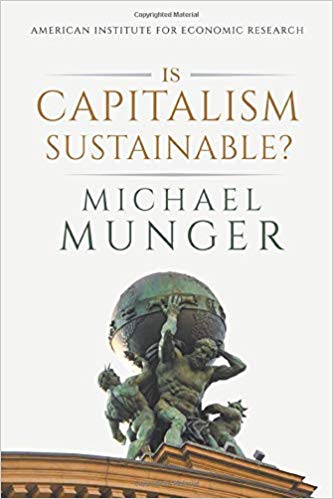The Future of Academic Publishing

The caricature of academic life is “publish or perish.” The phrase first appears in University of Texas President Logan Wilson’s 1942 book, The Academic Man, though the actual origins may date to the first uses of tenure in universities, dating in the U.S. from the 1870s. What it means to “publish” can vary, but the standard usually requires that the work be “peer reviewed,” a process described at some length here by Charles Fox.
This system is anachronistic, and is an active impediment to the creation and dissemination of knowledge. I understand that it is fashionable to say, “So what? The stuff academics write about is overly specialized and irrelevant,” but that is an EFFECT of the journal article system. It doesn’t have to be that way. As Dan Klein and Charlotta Stern argued in 2009,
Research is highly specialized, and the tribe is broken down into subfields. U.S. history, for example, might be broken down by period, by aspect (social, cultural, economic, gender, political, legal), by mode of research, by theme or character. Prestige and eminence are determined within the subfield, a kind of club within the tribe. The clubs constitute the tribe, just as agencies and branches constitute the government. Each club sorts people with overt reference to pedigree, publication, citations, and letters of reference. The club controls these filters and then applies them to itself. It controls the graduate programs and journals. By spawning and hiring new recipients of Ph.D. degrees, the club reproduces itself.
Why would a system that is supposed to produce and disseminate truths and new important questions be organized in a way that produces almost the opposite outcome? It wasn’t always that way. And as I argued earlier, the lesson of the “Chesterton fence” is that such structures once had a purpose, and may still have valuable elements that we shouldn’t simply throw out.
Three Features: Publication, Curation, and Verification
There are three features of academic publication that are indispensable. The question is how to preserve what’s useful while working out the problems that are useless, and in fact actively destructive.
Publication: There was a time, not so long ago, when journals and books were published on paper, and available in the library. Researchers often had “carrels,” or some space in the library where they could temporarily store physical published items. Beginning in the 1960s, and universally by the 1970s, university libraries also featured coin-operated copy machines. The stack of journals near the copy machines was so large that there was a library worker whose full-time job was simply reshelving the journals correctly.
What that meant was that article submissions, sharing the article with reviewers, and communications between authors and editors all had to be conducted via snail mail, on physical paper. The process was already long, requiring weeks just for shipping materials back and forth. The work of “typesetting” the articles accepted for publication was expensive and time-consuming, representing substantial fixed costs for each article.
The same was true of books, of course: the setup costs of typesetting and formatting were most of the cost of a book, with marginal cost being low enough that large print runs could be made available cheaply. But most academic books did not have large print runs. That meant that there was a powerful constraint on the number of pages and words that could be made available. If someone said they were reading “a journal article,” that meant they had the physical journal or a xeroxed copy of the article in their hands. Reading a book meant holding a physical, expensive thing.
This made a lot of sense, as long as the act of publishing provided the service of making the message widely available by providing a mass medium. Printed words in books revolutionized the world, and liberated content from small circles of nearby elites. If you could read and write, you could talk to millions. As John Man argued, in The Gutenberg Revolution, the “invention” of the mass-produced book was as important to the onset of modernity as the works of Machiavelli or Hobbes that were produced in books as a result.
But this conflation of medium and message was not inherent, and it was not permanent. Now, most of the time when I’m reading a journal article I’m looking at an analogue image of a digital file, displayed on my laptop computer screen. I may be reading a book, but it’s on Kindle or some other device. The word book can mean the physical thing, the words that the book contains organized into a file, or both.
With the splitting of the medium and message comes the manumission of content. It is now easy to “publish,” and to make the written message available to billions of people, simply by openly placing it on the internet. There is no reason to have the number of words or pages be constrained, except by the availability of human attention.
Curation: So long as publication was expensive, curation—this is important and worth your attention; that other thing is not—was performed almost invisibly. Nothing could possibly be published unless someone thought it was important. Commercial booksellers measured importance in terms of potential profits, and academic societies measured importance in terms of opportunity cost: with so few journal pages available, publishing article X meant that article Y would not be available, hidden behind the dissemination barrier. Since there were also few journals, a publication was inherently important, and likely to be read and noticed.
For that reason, academics started to use publication as a measure of importance, and ultimately of achievement. Judging quality of teaching is hard, and judging the importance of something a scholar wrote is even harder (you’d have to know something yourself!). The saying—unfair but not entirely inaccurate–among academics, is “Deans can count but they can’t read!”
Verification: At this point, there was actually a positive development. Not a universally positive development, but overall a good thing. That thing is “the review process.” Publishing journals was expensive, because of the setup costs of printing and mailing, and also because space was so limited that publishing one article precluded publication of another article, one that might very well be more important. Whether out of a sense of professionalism or under pressure from academics who increasingly depended on publications for prestige and promotion, journal editors started “referring” papers to experts. These “referees” would advise the editor on whether the paper should be published, and advise the author(s) on how to make the paper better.
Academic publishers used a similar, though not identical, process in making choices about which books to publish. Again, the process was not perfect, but given the increasing competition for publication some rationing scheme was necessary and the review process ensured both the curation and verification processes were carried out systematically.
A Cowardly New World
Given the extent of the competition in modern academics for publication space, and the breakdown of the process of physical publication and dissemination on paper, we are nearing a state of crisis. There are more journals than ever, but many of those (and it’s hard to tell, without looking) are simply predatory outlets that charge professors to place articles for which they can then claim credit at hiring and promotion time. This means that the (mostly) unfakeable publications, commonly called “top journals,” command more of a premium than ever before. People spend years trying, and often failing, to place even one article in a top journal.
Of course, even at the best of times in the academic utopia the review process likely punished originality and throttled innovation. Gordon Tullock famously had several papers developing his theory of “rent-seeking” turned down by the best journals, only later to be published as books or, famously, in the then relatively obscure Western Economic Journal. Gordon Brady went back and considered the “opportunity cost” question, comparing “Tullock’s rejections” to the articles that the top journals published instead. One might object that this is cherry-picking the rare exception, but it is if anything even more surprising that Tullock’s works became so widely cited, given their humble publication outlets.
Paradoxically, it appears that there is more money in publishing than ever before. The artificial scarcity caused by the explosion in efforts to publish—and not perish!—has given publishers power. If you think about it, the process is asinine.
1. Universities pay professors to spend thousands of hours on research.
2. Professors pay professional associations, through dues and subscription fees, to run journals.
3. The journals make the professors pay submission fees to consider the work that the professors are submitting—for free!—to the journals.
4. Referees are asked to subsidize this process by donating (in most cases, for free) their time to review the papers and submit a report.
5. The editor forces the authors to make extensive revisions. At the end of a long process, the editor will accept 10%, and often much less than 10%, of the papers submitted.
6. After this process is completed, the journal publishers sell the rights to view the work produced by the professors and paid for by the university in the form of electronic subscriptions that run thousands of dollars per year. That’s right: after the universities donate the content for free, the publisher puts that content behind a paywall and sells it back to the university, behind a paywall!
7. The professors who manage to win the lottery and get a publication in a top journal can use the fact of the publication, for which the university has been paying the professor’s salary, as a way to force the university to pay that same professor a higher salary.
And, as I noted above, that’s if the system works! Many publications are neither curated nor verified, and are simply published in “journals” or “books” that 20 years ago would not have even been considered publications. There has been a publication paroxysm, with hundreds and hundreds of “academic” books published with price tags of $100 or more.
Publishers know they will only sell 300 copies or so, and that to libraries, but that’s enough to make money. Such publications are the intellectual equivalents of the “NINJA” mortgage—“No income, no job or assets.” Why would a bank write a NINJA mortgage? Because they had a captive market: Fannie Mae and Freddie Mac, who would commoditize the debt and resell it to dupes. Publishers are selling books to libraries, and they don’t care much about the quality of the book being sold.
As “Anonymous Academic” put it, in the Guardian:
[I’ve] been asked to write a book about whatever I wanted, and this editor didn’t even know whether I’d written anything before. It didn’t matter. It would sell its 300 copies regardless. Not to people with an interest in reading the book, but to librarians who would put it on a shelf and then, a few years later, probably bury it in a storeroom.
Most academics get these requests. A colleague was recently courted by an editor who, after confessing they only published expensive hardbacks (at around £200), explained that this was an opportunity for my colleague to enhance his academic record. He was told he could give them pretty much anything, like an old report, or some old articles.
This is the endgame, and again the analogy to the financial crisis in 2008 is useful. Right up until the final apocalypse, there were people who thought everything was just fine. I expect that in 20 years most or all the following things will be true.
1. University libraries will have ended the practice of having standing orders for publishers, perhaps even including the top academic presses, because of the abuses and fraudulent practices of publishing bad books at inflated processes.
2. The referee and editor process that is now such a bottleneck in the careers of young scholars will have largely disappeared, replaced by a transparent synchronous peer-review process based on conferences. This practice already exists in computer science, and while it is far from perfect it cuts out the 4-year wait between submission and publication. A paper will be published online within a few days of the time it is presented at the conference, with comments and reviews of the paper simultaneously published almost in real time. (The first online-only journal in the humanities, Postmodern Culture, was started in 1990, a full 30 years ago).
3. The curation process will be handled by reviews, and citations from other work. It works for Amazon, and Rotten Tomatoes!
4. The verification process will be handled by pseudonymous reviews, using avatars that will be credited with academic prestige because of the quality and depth of their reviews. A good and useful online review would itself be a publication, and will count as such.
Of course, I may be wrong about the solution. But I hope I have persuaded you I am not wrong about the problem.
My most recent book was published by AIER. It was not refereed, and was published within two months of the time it was finished. It was available immediately as an online ebook, for $5. The print version is $18.
No taxpayers or university libraries were defrauded in the making or sale of that book.
Note: I want to thank Ed Lopez and the “Scaled Up Seminar” participants for giving me a chance to make the lunch talk on which this piece is based.












